A freak heatwave has pushed the North Pole temperature to above freezing, about 20°C above average.
Nearby:
-
An Arctic monitoring point 300 kilometres from the Pole that had been recording -37°C on Monday had shot up to -8°C by Wednesday.
Smack over Iceland was Storm Frank, which battered Scotland and Northern England:
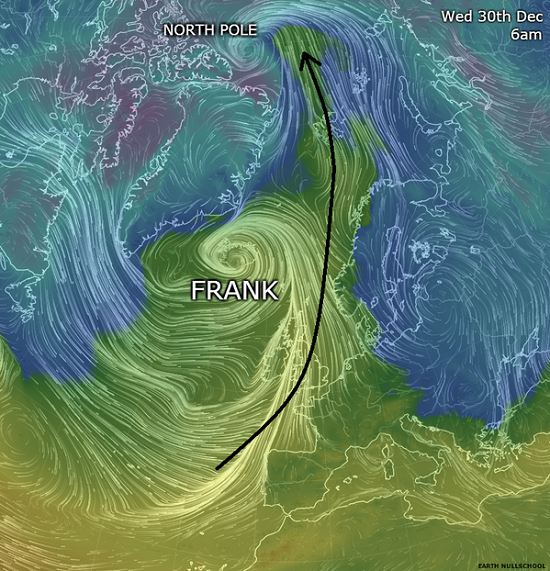
Winter began on both sides of the Atlantic with exceptional warmth. This image shows the temperature anomaly (in Fahrenheit) over the USA from 1-19 December:

At the Austrian ski resort of Grossarltal there was a stark difference in the snow conditions compared with the previous year:
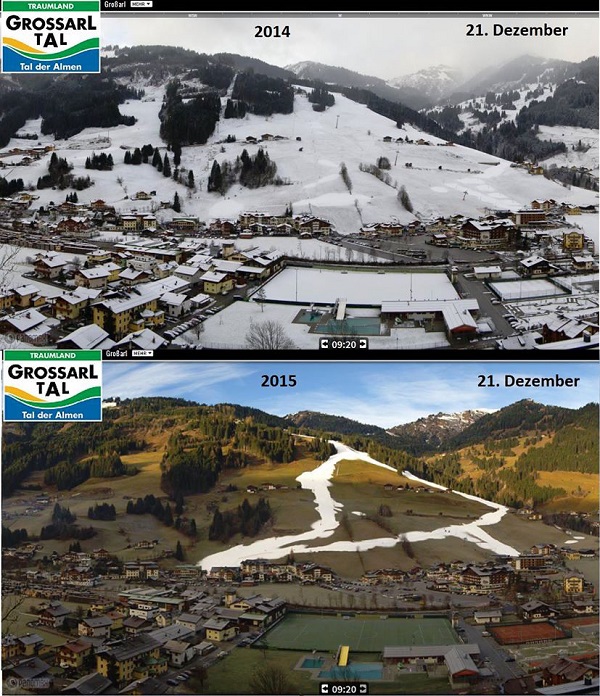
At Christmas tornadoes raked the Mississippi delta, followed by floods. This is what the temperatures looked like on 30 December:
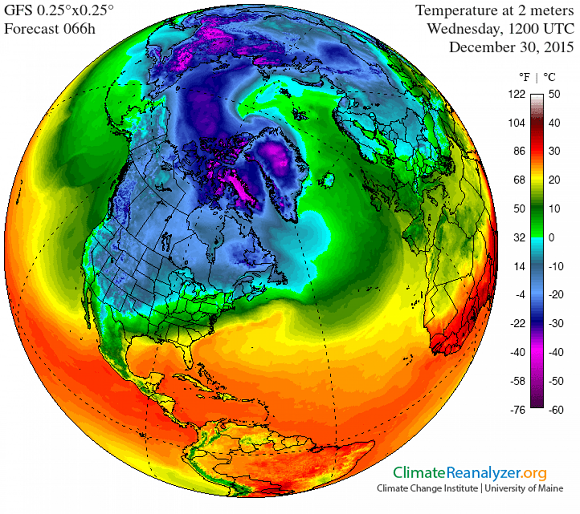
It shows 10°C heat reaching right into the Arctic. And that means rain. To robertscribbler rain in winter means the end of winter as he knew it:
-
As the first front of warm air proceeded over the ice pack to the north of Svalbard, the rains fell through 35-40 degree (F) air temperatures. It splattered upon Arctic Ocean ice that rarely even sees rain during summer-time. Its soft pitter-patter a whisper that may well be the sound to mark the end of a geological age.
For we just don’t see rain over Arctic sea ice north of Greenland during Winter time. Or we used to not. But the warmth that liquid water falling through the black of what should be a bone-cold polar night represents something ominous. Something ushered to our world by human fossil fuel industry’s tremendous emission of heat trapping gasses. Gasses that in the range of 400 ppm CO2 and 485 ppm CO2e are now strong enough to begin to roll back the grip of Winter. Gasses, that if they keep being burned until we hit a range between 550-650 ppm CO2 (or equivalent) will likely be powerful enough to wipe out Winter as we know it entirely over the course of long and tumultuous years of painful transition.
What does the beginning of the end of Winter sound like? It’s the soft splash of rain over Arctic Ocean sea ice during what should be its coldest season.
Inevitably the question of links with climate change will be raised. This article takes a look.
Storm Frank was, of course preceded by Storm Desmond in early December and then Storm Eva.
They say:
- climate change has increased the chances of Desmond-like storms by about 40 per cent – give or take a rather large margin of error.
And with each degree of temperature rise the atmosphere can hold 7% more water.
Other than that you’ll have to wait and see. Is this the new normal? No, ‘normal weather’ is a thing of the past.
You’ll be happy to know that there is no trend in the numbers of category 5 global tropical cyclones, although the numbers in the last two years have been high. But then Desmond, Eva and Frank were extratropical cyclones, and I’ve not seen the numbers for them.
Update: I’ve added here the mean anomaly for the Australian temperatures for 2015, from this BOM site. The reference temperature is the 1961-1990 period, which would of course already contain considerable warming:
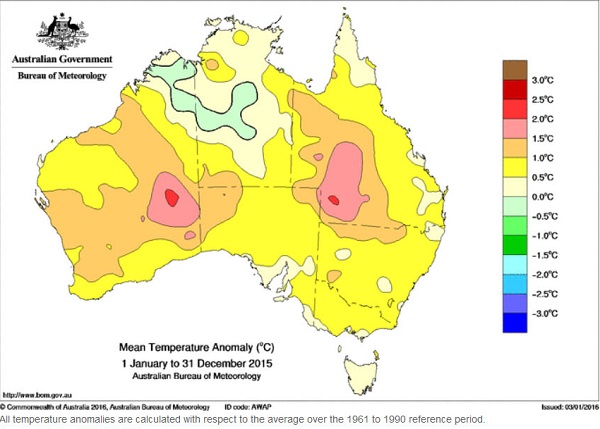
Update 2: In view of the comments I’ve added an image of the early October temperature anomalies from this post by two Australian scientists:
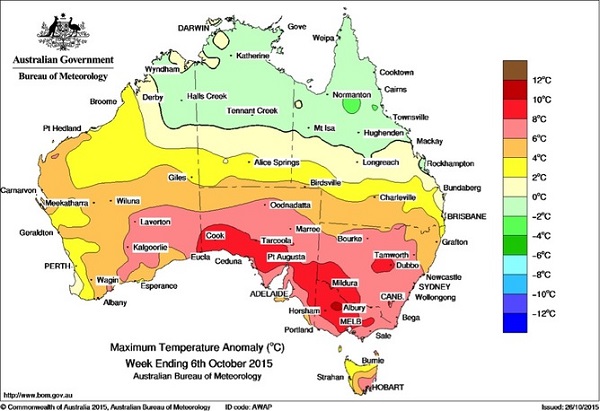

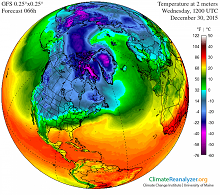
It’s not as dramatic as the story above, but …
I’ve looked at the temperatures from the nearest weather station to me (Essendon Airport, Vic) and the December mean maximum temperature this year was 28.9, which is 4.5 degrees above the average for that station (24.4).
Of course this was El Niño conditions, but the Essendon station has over 50 years of data (1940-72 and 2003-15 http://www.bom.gov.au/climate/data/index.shtml?bookmark=200) and thats the highest December mean ever recorded there, by almost a full degree.
Do other people ever get the feeling that we’re just not panicking enough? I’m a believer in the importance of hope and positivity, but at the same time temperatures nearly 5C above the long term average don’t seem to be getting the attention they should.
January and February are predicted to be not particularly hot in Melbourne, so I guess everyone will forget about the freaky December weather. It’s the old boiling frog thing. Would be interested to hear what people in Adelaide are thinking though.
Sorry the station has over 40 years of data I mean!
Val, calm down.
Unless the Australian average went up 5 degrees, and it didn’t, then somewhere someone enjoyed a 5 degree cooler average.
You won’t see them on the news.
Jumpy you are kidding yourself. The average temperature in Australia has already increased by 1C and we will get these extremes more often. What people who know about climate are worried about is that the climate will get worse more quickly than the IPCC predicts. The post by Brian is an example of the kind of things that may happen more frequently.
I am not really advocating “panic” of course, as I’m sure you know, just a sense of urgency.
Just taking a quick look at the BOM maps (because really, who can trust them?) it would appear the only parts of Australia with a cooling trend are in the Kimberleys and the Northern Territory.
That 5 degrees “cooler” average Jumpy is fantasising about probably equates to it being 35 degrees instead of 40.
And BTW, by how much did the Australian average rise? 2015 was the hottest year on record I believe.
zoot, a cooling trend ? Really ?
In places sandwiched between vast heating deserts and a vast heating ocean ?
Please link to this impossibility.
Not sure about the Kimberleys, or a ‘trend’, but if you go here and click on Mean anomaly and 12 months, you’ll find that it was cooler than average in the NT in 2015. I’ll post this and then edit it and I should be able to add the image.
The reference temperature is the 1961-1990 period, which would of course already contain considerable warming.
‘Waterworld’ already?
The image is now there.
Val, I’m expecting a statement from BOM about the 2015 weather to fall off the back of a truck shortly, like this one for 2014. Then eventually BOM and CSIRO should do a State of the climate report for 2015.
Statements like this are of concern:
That’s again compared to the 1961-1990 average.
On the whole, though, Australia is not all that important. Warming is greatest in the higher latitudes on land, and that’s where the ice sheets are.
But you are right, we should be alarmed and doing more than we are.
Just for you Jumpy: http://www.bom.gov.au/climate/change/index.shtml#tabs=Tracker&tracker=trend-maps&tQ%5Bmap%5D=tmean&tQ%5Barea%5D=aus&tQ%5Bseason%5D=0112&tQ%5Bperiod%5D=1970
Jumpy, now that I’ve done your research for you, it would only be good manners for you to return the favour and find us the weather station with an average that was 5 degrees cooler this December. (I admit I can’t find it)
That’s very distinctive zoot and just like you said. To some degree it matches increased rainfall.
This map posted at Climate Central shows the astonishing east-west variance in the US – cool in the west and very warm in the east.
They are expecting winter to begin in earnest about now with the polar vortex weakening and spilling cold air over North America.
Zoot, you do know how averages are calculated right ?
Could someone tell zoot how much the temperature in Australia has risen, using 10 year running averages, over the last century please.
I did as requested, demonstrating BTW that it was not in fact “an impossibility”.
I’m merely asking you to please link to “the somewhere” where “someone enjoyed a 5 degree cooler average.”
Apparently you don’t feel it necessary to adhere to the standards you set for others.
Right! … Do you??
Here’s a trivial example that suggests you may not.
Imagine 100 weather stations each of which has an average maximum temperature for the month of 20. The next month one of them has an average maximum temperature of 24.95, but the other 99 each have a (slightly) lower average maximum of 19.95.
The average for the hundred stations doesn’t change (do the math), but neither does any of the stations enjoy a 4.95 degree cool spell.
Alright, is there any way we can turn these changes to our advantage?
And, just for fun, how do the Taswegians get on if the Roaring Forties stop roaring and their mighty hydroelectric power system becomes less mighty than they have been accustomed to?
Congratulations zoot, you’ve just demonstrated to Val how anomalies can fool in an overall unchanged group.
Thank you, it was hard work.
As for the ” 5 degrees cooler place ” , you just demonstrated it was spread over a bigger area than Essendon Airport.
Been great chatting…..
Two erroneous assumptions in quick succession.
Nice one Jumpy! Is this a personal best for you?
Just a bit more on the climatic future of Tasmania:
Wonder if conservationists, not to far into the future, will demand a dam be put in to prevent the level of Lake Pedder dropping by more than 5 Metres? Just a thought ….
The BOM has produced a climate report on 2015 http://www.bom.gov.au/climate/current/annual/aus/2015/
It was the fifth hottest year on record and the mean temperature was 0.85C above the average. As Brian has previously pointed out, the average (generally calculated on 1960-90 figures for these purposes) already incorporates some degree of warming, so Australia’s climate has now warmed by over 1C above preindustrial times.
Jumpy if you are seriously trying to suggest that because I noted that the December maximum at Essendon Airport was almost 5C above the average (of all recorded results for that station), I must therefore believe that the average temperature for the whole of Australia was 5C above average, then there’s nothing I can say to you.
The point is (as I’m sure you actually know) that the normal curve of temp is shifting to the right and as that happens, you will also get more extreme hot days. It’s well known. Please try to talk sensibly about these matters.
Should have been 0.83 above not 0.85, sorry
Val
When I hear ” …if you are seriously trying to suggest…” then I’m pretty certain I didn’t. And this no exception.
I just wanted you to calm down and I’m glad you back-pedalled from *””Do other people ever get the feeling that we’re just not panicking enough? “”*
Now 2 questions for the group;
1] In your opinion, for the optimum health of the Earth, humanity, all animals and plants etc.., what is the optimum sea level, temperature, number of floods, droughts, storms ( tropical or extratropical ), snow fall, ice extent ( north, south and elsewhere), co2 level, glacial movement or standard of human happiness ?
2] What year was that ?
Shorter Jumpy:
Look! … Over there!
Honest questions zoot, need to know where we’re aiming at,
With no target, what’s the point ?
Do you have the answers to those 2 fundamental questions or not, it’s ok if you don’t, just say so.
Interesting question Jumpy. Part of the answer is that change is the most threatening thing. I don’t mean change like cycles of floods etc. because this this level of variation provides the ecology many species depend on.
On the other hand sea level changes and other changes due to climate change will produce winners and losers.
Jumpy, probably because I’m a suspicious old curmudgeon your questions look to me like simple trolling.
Please demonstrate your good faith by telling us your answers to them (you do have answers, don’t you?)
We already have targets.
Calm down yourself Jumpy. I don’t blame you for being scared of women, I realise you can’t help it, but you have to learn to deal with it. Trying to patronise a woman may make you feel better temporarily but it doesn’t help your real problem.
John
Thanks for you thoughtful considered answer.
To me that’s the guts of it, winners and losers.
We all must admit that FFs have benefited humanity enormously.
Even everyone on this blog still benefits on a daily basis.
Certainly saved the whales from extinction.
I’m just trying to figure out what is considered ” optimum ” and for which Earth bound entities. Is there a ” normal ” and what is it. For whom are we saving what.
Struth, some would freeze to death tomorrow without FFs, should I take it away.
That kinda shit.
( zoot, I don’t know, hence the question. Your coming across as a bit paranoid )
I’m surprised you don’t have an optimum number for floods, droughts, storms ( tropical or extratropical ), snow fall, ice extent ( north, south and elsewhere), co2 level, glacial movement or standard of human happiness, yet you apparently expect us to provide one.
Another example of you expecting others to meet standards you won’t hold yourself to?
My answer? The question is meaningless as there is no “optimum” number of floods, droughts etc etc etc and to have one as a target would be so unrealistic as to be deranged. So that’s two people so far who have answered your ill formed questions.
How about repaying the favour and telling us where the weather station which had a 5 degree cooler average for December is located.
There’s one in Antartica, fetch.
I’m tired of trying to explain anomalies, data spread and how averages are calculated.
Your getting a little creepy obsessive now, I’m dropping it, you do whatever.
Jumpy:
Stop looking in the mirror and the problem will go away.
John
Must be my fear of women.
Over and out.
I think that got a bit over-personal. Sorry Jumpy.
To take your question seriously, I don’t think there can be agreement on an ideal state of the climate, because, as John said, there will be winners and losers.
There is also a lack of knowledge. For example the North Atlantic is the only cyclone zone that has accurate records past the middle of last century.
Moreover the ecosystem changes in important ways that can’t be reversed. Hence we should think about what is to come.
I’d keep an eye out for sea levels. I’d like to see the sea 10 or 15 cm lower than it is now. That would require cooling, and probably CO2 at 280ppm or even lower. It depends on what massive vegetation changes have done to the earth’s reflectivity.
If we leave CO2 where it is now for a few thousand years, we could get sea level rise of 25 metres, plus or minus five, as I outlined in this post.
Brian I object to being told more than once by Jumpy that I need to “calm down” when I’m expressing genuine concern about climate change. It’s patronising and rude and as a woman I am entitled to object to this kind of stereotyping. If Jumpy doesn’t want blowback he shouldn’t say that kind of stuff. I won’t say anything further out of respect to you, but Jumpy is trolling by that kind of behaviour and doesn’t deserve apologies in my view.
Fair point, Val.
Thanks Brian. Again, I’m not trying to go on about it unreasonably, but there is another point that’s occurred to me as well as the sexism angle. When you’re talking about abnormal heat in Victoria, you’re talking about one of the most fire prone areas in the world, and I think most Australians would know that.
Many Victorians, like me, would have had first hand experience of bushfires and may know people who have died or lost their homes in bushfires. It does seem pretty insensitive to be telling people to “calm down”, or asking what it is they’re actually worried about, in those circumstances.
Also – while I’m on about it – I admit that me saying Jumpy was scared of women was just an example of me getting exasperated and trying to show him what it’s like to be patronised – and probably a mistake – although I do wonder what motivates some men to patronise women …
Ok will stop now
The biggest Victorian bush fire ever recorded was in 1851.
Nothing since has come close and probably never will.
Jumpy, my sense is that you are a climate change denier and you will look for any evidence you can to confirm your pre-existing views, so it may well be useless talking to you, but I’m going to try anyway.
Victoria is a high risk bushfire area particularly because of its eucalyptus forest. Approximately two thirds of the native tree cover has been removed since white settlement (http://m.jpe.oxfordjournals.org/content/5/1/109.full)
Closer settlement in Victoria largely followed the gold rush period from the 1850s, so most tree clearing would have been done after the 1851 bush fires. Moreover at that time there was nothing like the organised response to fires we have now. Therefore the fact that the 1851 bushfires covered a very large area is not directly comparable to present day conditions.
You could compare the 1851 bushfire to the 2003 fires in the Gippsland forests, which burnt over a million hectares with no direct loss of life (there was indirect loss of life following the fires). Had there been as much forest in 2003 as there was in 1851, the fires might well have been more similar in size.
The more useful comparison, however, is to look at the frequency of major fires (for this I’m using Wikipedia, which may not be the best source but I think is adequate for the purpose of this discussion https://en.m.wikipedia.org/wiki/Bushfires_in_Victoria)
Of the nine most extensive bushfires listed in Wikipedia, you can see that there were two in the second half of the 19thC, two in the first half of the 20thC, two in the second half of the 20thC and three in the first ten years of this century.
Thats a pretty striking figure. I think people living in Victoria have every right to be concerned about climate change and bushfires, without people like you cherry picking the figures to support your pre-existing views, don’t you?
Val, I was a bit tired last night, and had forgotten entirely your interchange with Jumpy. It’s classic sexism, really. Women are seen as emotional, excitable and even hysterical.
Logically, it now belongs better on the later thread on Australian climate, but the conversation started here. This post by two Australian scientist specifically addresses the heat in October and links it with climate change. Have a look at the first image which shows the temperature 8C or more above average in a fair slab of country, mostly Victoria. It’s entirely without precedent, apparently.
Here’s the image:
Val
You are correct in that land clearing and other human activities have lessened the size of bushfires.
It is also true however that the frequency can also , in part, be put down to human activities as around 75% are deliberately or accidentally lit by people nowadays. With population growth comes the increased prevalence of arsonists and idiots.
( I regard ” climate change denier ” as a juvenile, no substance insult like ” poo poo head ” that is weak no matter who uses it. and I’d be happy to discuss ” sexism ” [ your favourite subject] on the open thread, if Brian allows. But not here. )
Seems appropriate for here:
http://www.abc.net.au/news/2016-01-08/perth-fire-creates-own-weather-system/7076884
Thanks Brian. The temperature anomaly in October was even more striking than in December, it seems – I remember reading that Conversation article, it was a good article. I’m happy to take any further discussion to the more recent thread if you prefer.
Discussion can stay here, Val. I’ll put a reference on the other thread.
Heck, I look away from this site for two minutes and a pub brawls starts.
Jumpy and Val: There were indeed severe bushfires – and floods- in the first decades of white settlement. And land clearing probably was a mitigating factor in later bushfires.
However, what about bushfires BEFORE white settlement? Enough of Australia has been dug up and analysed to give some sort of a picture of bushfires in ancient times – as well as chance finds of Aboriginal remains that had not been given funerary attention. I find it hard to believe that all Fire-stick Farming had benign outcomes – or that there was an abrupt change in the nature of bushfires as soon as white-fellas came over the horizon.
There is research available on how Aborigines adapted, in general, to millennia-long changes in climate but what about the day-to-day or season-to-season stuff like bushfires?